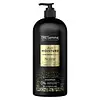What's inside
What's inside
 Key Ingredients
Key Ingredients

No key ingredients
 Benefits
Benefits

 Concerns
Concerns

 Ingredients Side-by-side
Ingredients Side-by-side

Water
Skin ConditioningSodium C12-13 Pareth Sulfate
CleansingCocamidopropyl Betaine
CleansingSodium Chloride
MaskingTocopheryl Acetate
AntioxidantAscorbic Acid
AntioxidantPanthenol
Skin ConditioningBiotin
AntiseborrhoeicNiacinamide
SmoothingDimethiconol
EmollientParfum
MaskingCitric Acid
BufferingGlycerin
HumectantSodium Benzoate
MaskingGlycol Distearate
EmollientCarbomer
Emulsion StabilisingSodium Laureth Sulfate
CleansingTea-Dodecylbenzenesulfonate
CleansingCocamide Mea
EmulsifyingGuar Hydroxypropyltrimonium Chloride
Skin ConditioningDisodium EDTA
PEG-45m
HumectantPPG-9
Skin ConditioningAmyl Cinnamal
PerfumingBenzyl Alcohol
PerfumingLimonene
PerfumingLinalool
PerfumingMica
Cosmetic ColorantCI 77891
Cosmetic ColorantWater, Sodium C12-13 Pareth Sulfate, Cocamidopropyl Betaine, Sodium Chloride, Tocopheryl Acetate, Ascorbic Acid, Panthenol, Biotin, Niacinamide, Dimethiconol, Parfum, Citric Acid, Glycerin, Sodium Benzoate, Glycol Distearate, Carbomer, Sodium Laureth Sulfate, Tea-Dodecylbenzenesulfonate, Cocamide Mea, Guar Hydroxypropyltrimonium Chloride, Disodium EDTA, PEG-45m, PPG-9, Amyl Cinnamal, Benzyl Alcohol, Limonene, Linalool, Mica, CI 77891
Cyclopentasiloxane
EmollientAlcohol Denat.
AntimicrobialPhenyl Trimethicone
Skin ConditioningDimethiconol
EmollientC12-15 Alkyl Benzoate
AntimicrobialChamomilla Recutita Extract
Skin ConditioningCocos Nucifera Oil
MaskingEthylhexyl Methoxycinnamate
UV AbsorberHelianthus Annuus Seed Oil
EmollientNelumbium Speciosum Flower Extract
Skin ConditioningBenzyl Alcohol
PerfumingCinnamal
PerfumingLinalool
PerfumingLinum Usitatissimum Flower Extract
Skin ConditioningCaprylic/Capric Triglyceride
MaskingGardenia Taitensis Flower Extract
Skin ConditioningRosa Canina Flower Extract
AstringentBisabolol
MaskingGlycine Soja Oil
EmollientParfum
MaskingCyclopentasiloxane, Alcohol Denat., Phenyl Trimethicone, Dimethiconol, C12-15 Alkyl Benzoate, Chamomilla Recutita Extract, Cocos Nucifera Oil, Ethylhexyl Methoxycinnamate, Helianthus Annuus Seed Oil, Nelumbium Speciosum Flower Extract, Benzyl Alcohol, Cinnamal, Linalool, Linum Usitatissimum Flower Extract, Caprylic/Capric Triglyceride, Gardenia Taitensis Flower Extract, Rosa Canina Flower Extract, Bisabolol, Glycine Soja Oil, Parfum
 Reviews
Reviews

Ingredients Explained
These ingredients are found in both products.
Ingredients higher up in an ingredient list are typically present in a larger amount.
Benzyl Alcohol is most commonly used as a preservative. It also has a subtle, sweet smell. Small amounts of Benzyl Alcohol is not irritating and safe to use in skincare products. Most Benzyl Alcohol is derived from fruits such as apricots.
Benzyl Alcohol has both antibacterial and antioxidant properties. These properties help lengthen the shelf life of products. Benzyl Alcohol is a solvent and helps dissolve other ingredients. It can also improve the texture and spreadability.
Alcohol comes in many different forms. Different types of alcohol will have different effects on skin. This ingredient is an astringent alcohol.
Using high concentrations of these alcohols are drying on the skin. They may strip away your skin's natural oils and even damage your skin barrier. Astringent alcohols may also irritate skin.
Other types of astringent alcohols include:
According to the National Rosacea Society based in the US, you should be mindful of products with these alcohols in the top half of ingredients.
Any type of sanitizing product will have high amounts of alcohol to help kill bacteria and viruses.
Learn more about Benzyl AlcoholDimethiconol is a silicone that resembles the popular dimethicone. Like other silicones, it is an emollient. Emollients create a thin film on skin to prevent moisture from escaping.
This ingredient helps to create a silky texture and improve spreadability. Due to its high molecular weight and thickness, it is often combined with cyclopentasiloxane.
Linalool is a fragrance and helps add scent to products. It's derived from common plants such as cinnamon, mint, citrus, and lavender.
Like Limonene, this ingredient oxidizes when exposed to air. Oxidized linalool can cause allergies and skin sensitivity.
This ingredient has a scent that is floral, spicy tropical, and citrus-like.
Learn more about LinaloolParfum is a catch-all term for an ingredient or more that is used to give a scent to products.
Also called "fragrance", this ingredient can be a blend of hundreds of chemicals or plant oils. This means every product with "fragrance" or "parfum" in the ingredients list is a different mixture.
For instance, Habanolide is a proprietary trade name for a specific aroma chemical. When used as a fragrance ingredient in cosmetics, most aroma chemicals fall under the broad labeling category of “FRAGRANCE” or “PARFUM” according to EU and US regulations.
The term 'parfum' or 'fragrance' is not regulated in many countries. In many cases, it is up to the brand to define this term.
For instance, many brands choose to label themselves as "fragrance-free" because they are not using synthetic fragrances. However, their products may still contain ingredients such as essential oils that are considered a fragrance by INCI standards.
One example is Calendula flower extract. Calendula is an essential oil that still imparts a scent or 'fragrance'.
Depending on the blend, the ingredients in the mixture can cause allergies and sensitivities on the skin. Some ingredients that are known EU allergens include linalool and citronellol.
Parfum can also be used to mask or cover an unpleasant scent.
The bottom line is: not all fragrances/parfum/ingredients are created equally. If you are worried about fragrances, we recommend taking a closer look at an ingredient. And of course, we always recommend speaking with a professional.
Learn more about Parfum